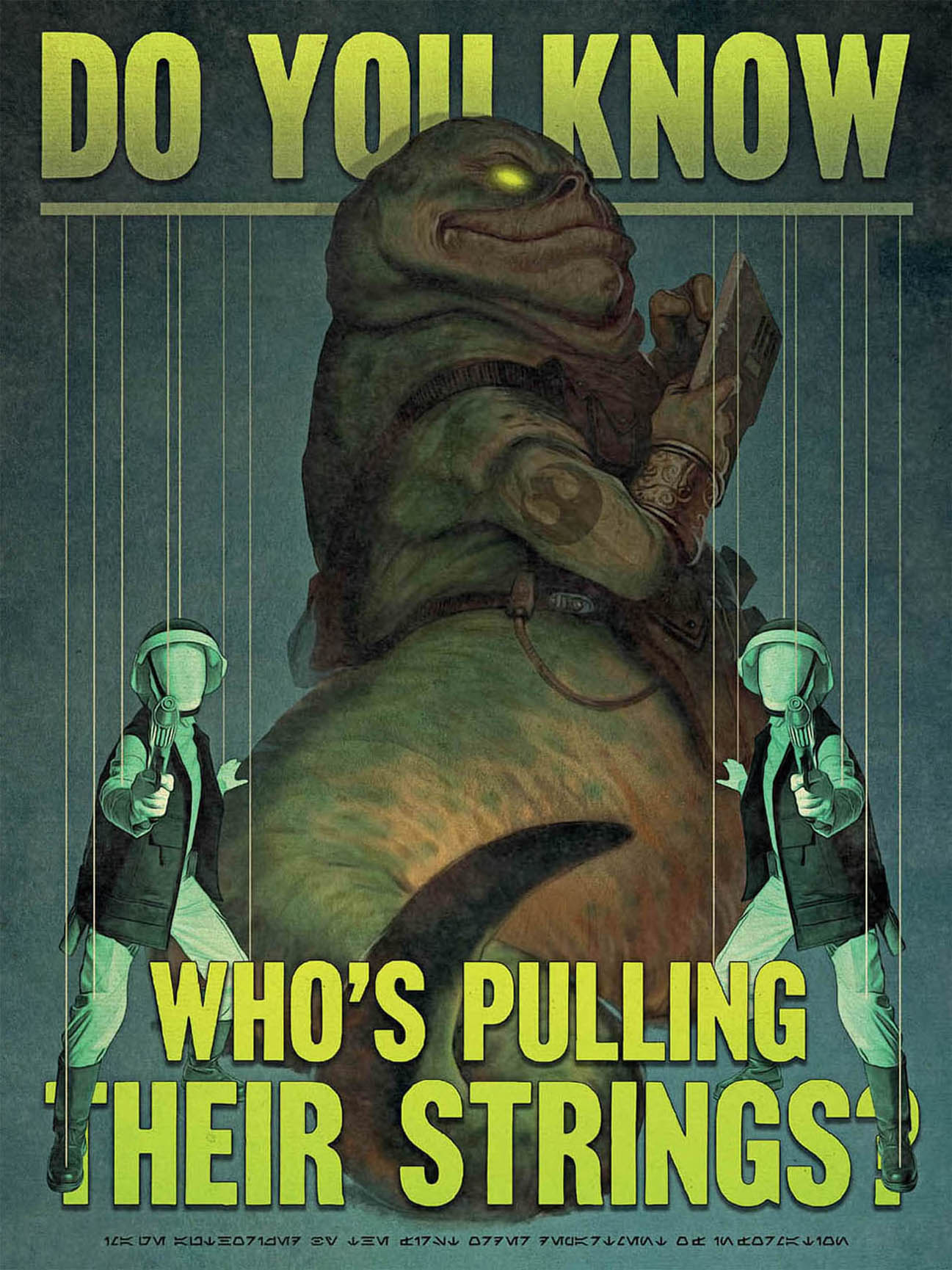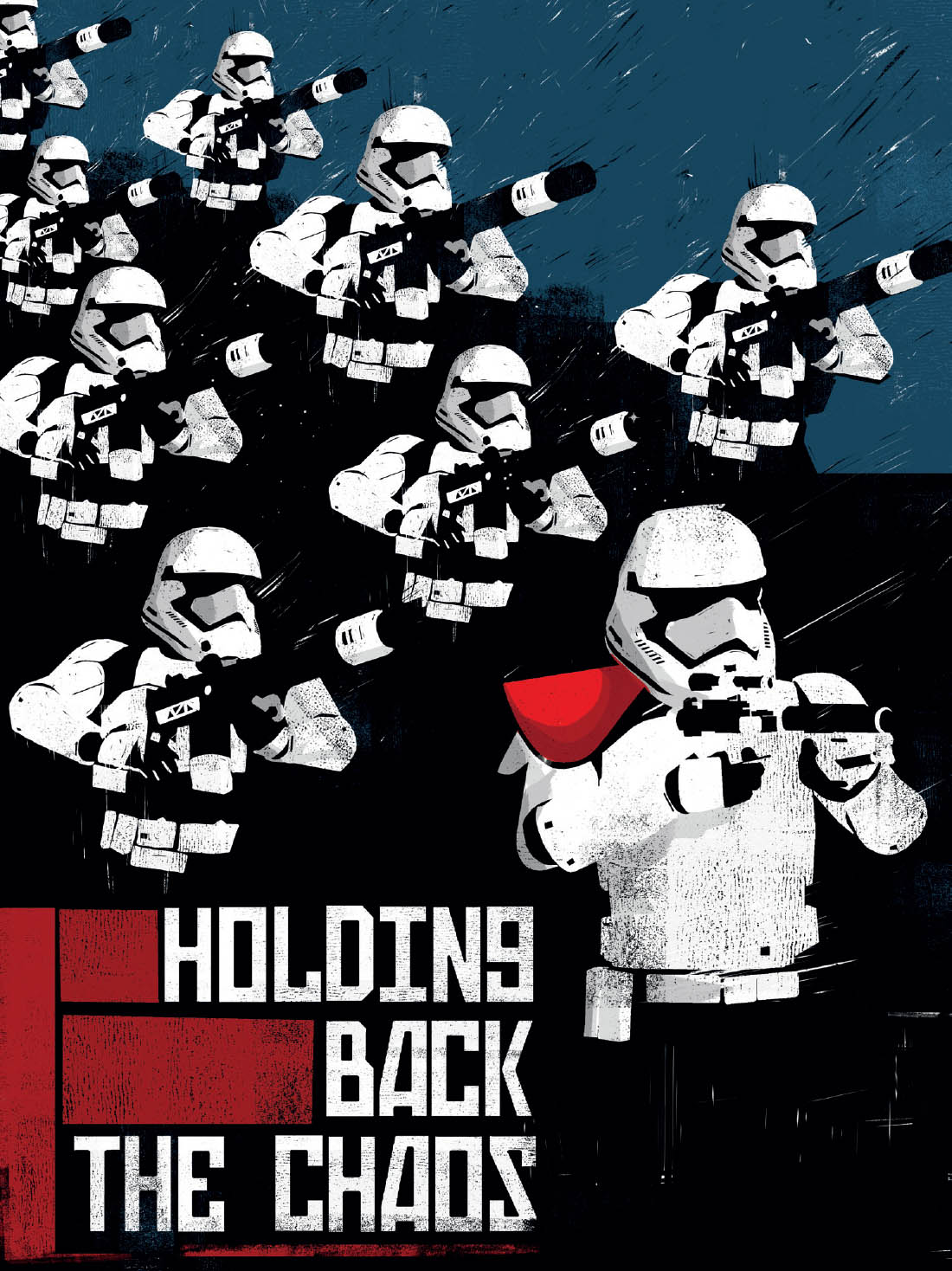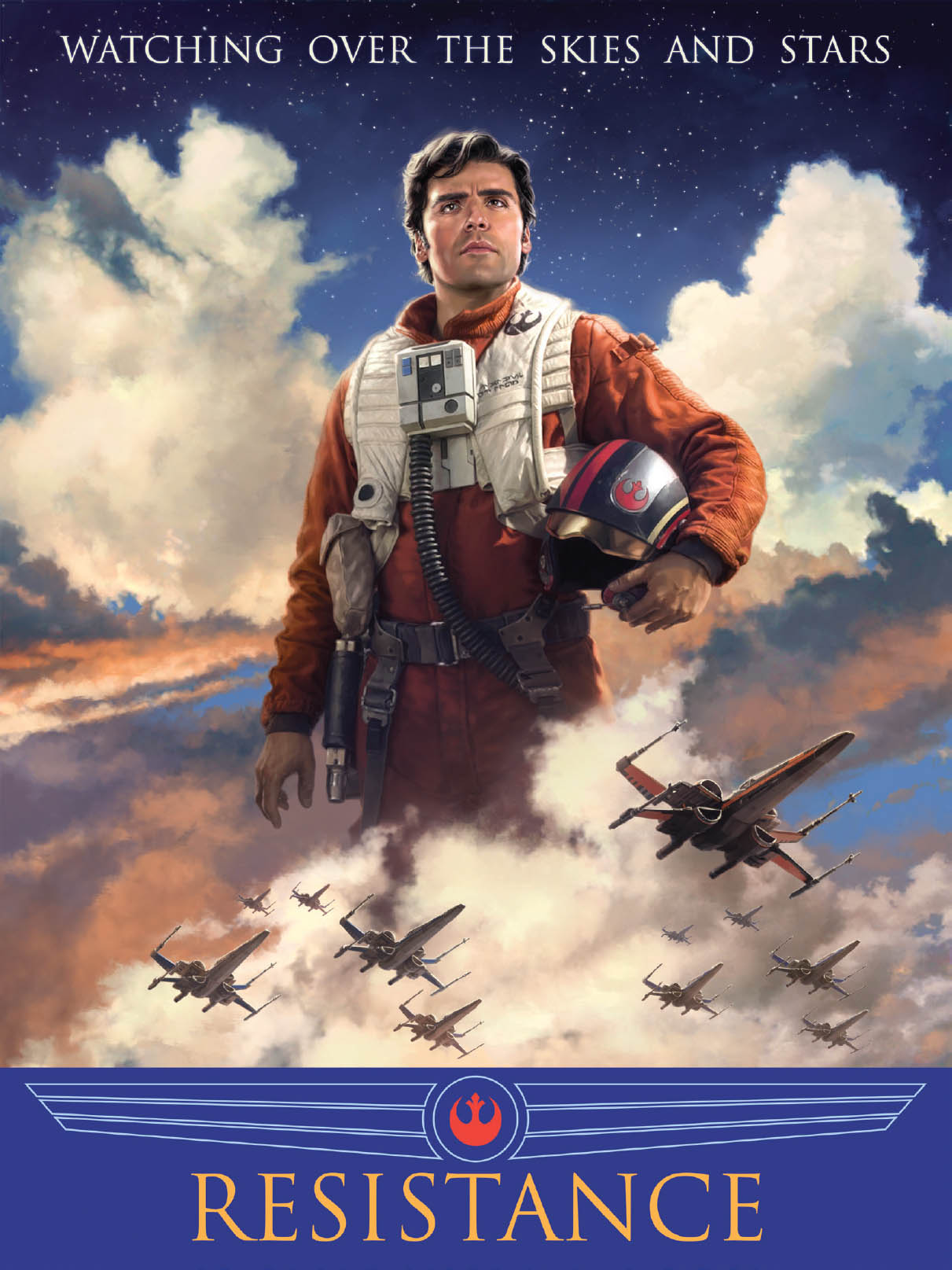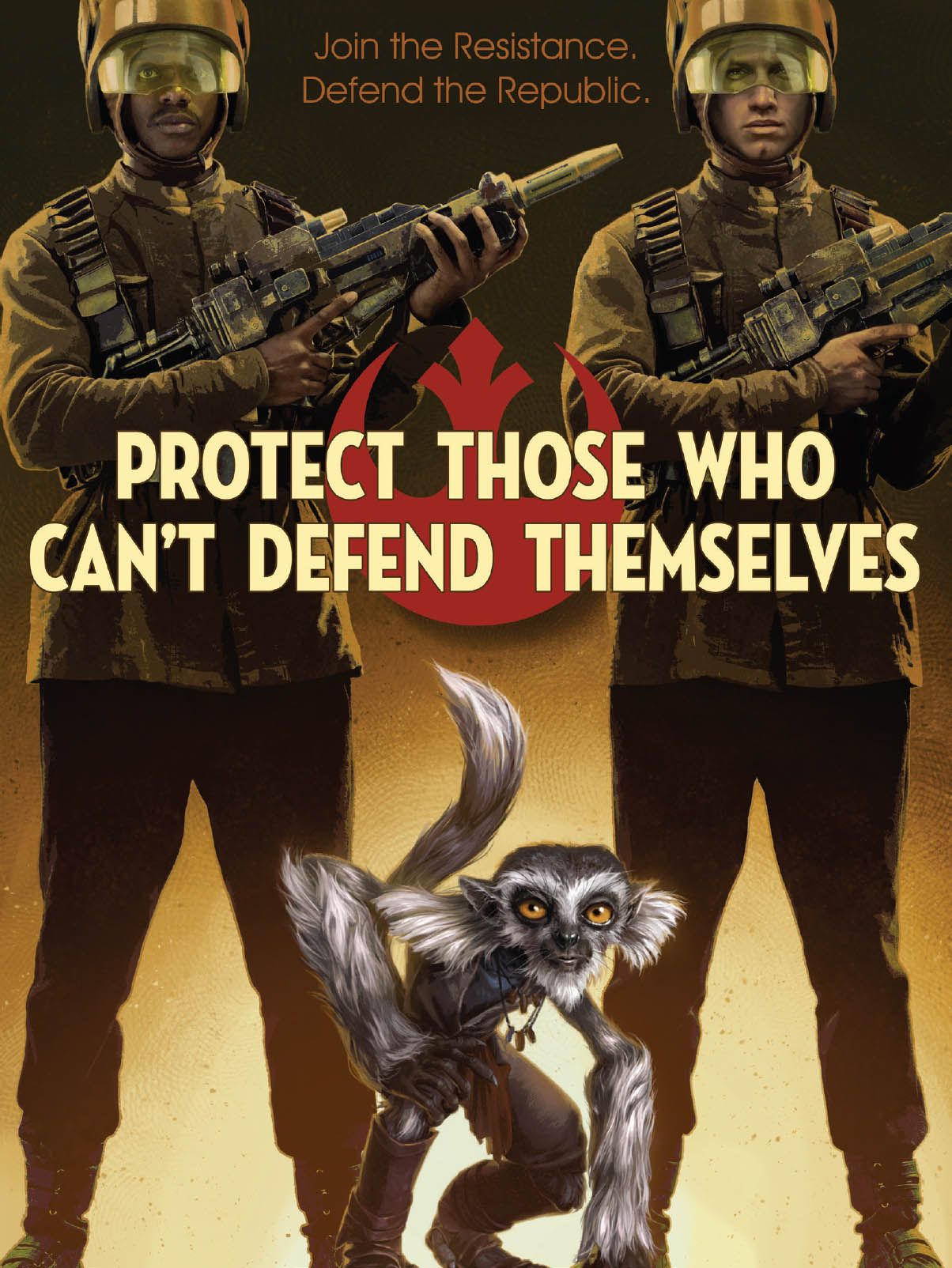
AN ORDER RESURGENT
The thousand-year regime did not outlive its founder. The death of Palpatine at the Battle of Endor threw the Galactic Empire into tumult, as the autocracy did not have instructions of succession in the event of such a disaster. Ambitious members of the Imperial Council attempted to grab onto their fiefdoms of power, while distant governors and Imperial military leaders seized what territories they could. Other loyalists tried to uphold Palpatine’s vision and considered such power grabs treasonous. Still more Imperials were relieved to be free of their sovereign and sued for peace with the victorious Alliance at their earliest opportunity.
This was a time of chaos. The Empire’s expansion stalled, and its aggression turned inward. Governors used their propaganda apparatus to spread tailored messages, which in aggregate were a contradictory and bewildering mess. Some, like Governor Adelhard of the Anoat sector, insisted that the Emperor lived on and that the Rebellion was spreading lies. Others downplayed the threat of the newly emergent New Republic, or refused to name it as such to avoid giving the victors any legitimacy. Some ramped up fear by describing the New Republic as monstrous terrorists, swallowing former Imperial worlds whole with their anarchy.
For the New Republic, it was a crucial time to avoid missteps. Mon Mothma insisted on absolute clarity of message—although she held the position of Chancellor, she made clear it was provisional. This new version of the Republic would undo the overreach of Palpatine and would be a government that was reflective of its members. The communication bureaus of the nascent Republic worked around the chrono to craft inspirational messages of invitation. Mothma aspired to host a Galactic Congress on Chandrila where worlds would vote on how the New Republic would be structured. The messages of rebirth, empowerment, and self-determination were strong—calculated to win back the former Separatist worlds that had no interest in the last Republic, let alone a new one.

Eric Tan
Upon its emergence, the First Order deliberately invoked imagery unseen for a generation. The skull-like monochromatic visage of the stormtrooper—a clear evolution of an Imperial design—figured prominently.

Brian Rood
The scope and scale of the First Order military operation came as a shock to a complacent New Republic. What were first thought to be local defenses and ceremonial forces proved to be just the tip of a larger invasion force.
The Galactic Concordance, the peace treaty that brought an end to hostility, was at last signed and ratified after the last remnants of the Imperial fleet vanished following the Battle of Jakku. Former Imperial governors were invited to the New Republic, though many of them bore the weight of crushing reparations.
Once the dust of the Galactic Civil War settled, the New Republic was a fraction of the size of the Empire and the Republic that preceded it. Its size was dictated by the egalitarian processes that created it. Many systems opted out of galactic representation, but remained on friendly terms with the galactic government. A Galactic Senate would convene on the capital—a capital that would have no fixed location and would travel to different worlds determined by election.
Over time, the former Imperials reunited as the First Order and coolly inhabited a wing of Republic politics until tensions reached a breaking point. The First Order seceded from the New Republic, a move that was welcome by many in the galactic capital. But others realized that without Republic oversight, the First Order would return to the Empire’s draconian ways and ambitious expansion. To counter this specific concern, Leia Organa of Alderaan founded the Resistance, a paramilitary group that probed the neutral space separating the First Order and the Republic for signs of treaty violations.
It was an age of interstellar tensions, of opaque political borders that fostered intrigue and suspicion. The New Republic obsessed over maintaining peace with a light hand, so as not to repeat the errors of the Empire. As part of the provisions of the Galactic Concordance, the New Republic instituted a drastic demilitarization meant to strip the galaxy of any single fighting force capable of vast conquest. New Republic politicians assumed the defeated Imperials would honor this treaty, and in fairness to their naivete, the hunger for peace was palpable across the galaxy. The Resistance tried to warn the Republic that the cost of peace was vigilance, although General Organa was subjected to accusations of fearmongering and saber rattling.
When the First Order’s true agenda was exposed in the most spectacular and horrific display of war technology known to history, these arguments evaporated as quickly as the worlds of the Hosnian system. The Republic was burned away in minutes, the result of long-term plotting on the part of the First Order. The minuscule Resistance instantly became the galaxy’s only hope. And emerging from the depths of hidden space, the First Order appeared as a fully mechanized military threat.
Once again, war engulfed the galaxy. Once again, the candle of hope guttered in the winds of troop movements. Once again, artists took up their tools to do their part in the next great war.

Russell Walks
A NEW DAWN
Janyor of Bith
At the dawn of the New Republic, Acting Chancellor Mon Mothma commissioned exploratory artworks to inspire a galactic populace newly liberated from Imperial oppression. Mothma rejected iterations that featured Coruscant as the seat of power. In notes carefully transcribed by the artist, she said, “We are not building the Old Republic. That system failed its people, for its failure to listen to their pleas. What we are building will be accountable to its citizens above all.” This finished image, inviting new representatives to gather, is instead of the Legislative Commons of Chandrila, the far humbler provisional capital.

Russell Walks
ENDOR IS A LIE
Artist Unknown
In a display of cynicism masquerading as unending patriotism, Governor Ecressys of the Velcar sector spread the word of the Emperor’s survival. It is doubtful Ecressys believed such claims himself, as contemporary records of his rule unearthed in ISB documents indicated that the governor was no loyalist to Palpatine. He was routinely overheard complaining about the lack of support from the Core, although Ecressys was political enough not to say anything too incriminating.
The narrative of the Emperor’s survival was a bid to prop up his own power. Ecressys did not wish to reveal just how vulnerable the Empire truly was, but figured he could hold his territory if he entrenched firmly enough within its borders. Ecressys executed his plan by controlling all communication within the Velcar. He had no endgame other than raiding the treasuries of the worlds under his command. By the time the New Republic arrived at his capital world to bring word of the Galactic Concordance, Ecressys had fled to the Western Reaches with the wealth of hundreds of worlds.

Russell Walks
WHO’S PULLING THE STRINGS?
Ferric Obdur (concept); Filris Parbert (artist)
Ferric Obdur was the chief information officer in the fragmented Empire commanded by Admiral Rae Sloane. It fell to him to win the hearts and minds of the beleaguered galactic populace, to create imagery and messages for worlds still in the Imperial thrall and in contested space targeted by the New Republic.
With this particular campaign, the goal was to implicate the New Republic as colluding with criminal organizations (a claim, ironically, that could be more readily lobbed at Imperial holdouts). Obdur was reportedly dissatisfied with the exact tone of this piece, saying it relied too much on inference. According to his notes, “We need that connection to be clear, concise: a hard slap to the face. Dose of reality.”

Marko Manev
YOUR WORLD NEXT
Artist Unknown, Anoat sector
The defeat at Endor radically upended the power structure of the Empire, and a government held together by fear of an unstoppable tyrant quickly splintered. A tide of revolution swept across the galaxy as fast as hyperspace travel and communications allowed. Some, like Governor Adelhard of the Anoat sector, attempted to stem the rise of rebellion by locking down the borders of his sector and maximizing control over his fiefdom. The government directly under his command spread word of the Emperor’s survival, even though pirated transmissions of the second Death Star’s destruction and the rise of the New Republic found their way through the cracks of his Iron Blockade. Adelhard’s agents countered such messages with imagery that recast the Republic as a tide of terrorism to be dreaded.

Joe Corroney
JOIN THE TIDE OF VICTORY
Janray Tessime
After the victory at Endor, Leia Organa began to appear more prominently in Alliance (and later, New Republic) propaganda, a role she was never truly comfortable with during the Galactic Civil War. Once she came to terms with her status as a symbol, she embraced it, becoming the voice of the growing New Republic in holographic transmissions broadcast to contested worlds. In addition to such messages, Leia appeared in poster art. This piece captures her in an imagined role of leading a group of SpecForce operatives. While no one contested that Leia had exceptional combat experience, this particular image came at a time when Leia had stepped back from the battlefront to concentrate on matters of politics.
Leia ultimately trusted Evaan Verlaine to manage her image. Leia herself felt she had much more pressing issues, both personal and professional, than the approval of likenesses in her portraiture.

Joe Corroney
REPORT IMPERIAL HOLDOUTS
Artist Unknown
The lengthy process of modifying, agreeing upon, and ultimately ratifying the Galactic Concordance resulted in a staggered annexation of former Imperial realms into New Republic territory in the months following the Battle of Jakku. Some sectors went without a fight and were eager to throw off the shackles of Imperial rule, while others proved more stubborn—on battlefields both literal and political.
In the Spirva sector, former governor Callidona Vens was so eager to prove her allegiance to the New Republic that she unloaded troves of former Imperial intelligence and instituted a campaign to oust Imperial sympathizers from within her borders. Her zealousness actually necessitated tempering from New Republic inspectors, who feared that Vens was fostering too volatile an atmosphere of paranoia and hostile condemnation during a time of reconciliation and reconstruction.

Scott Biel
PROTECT THE REPUBLIC
Janray Tessime
Decades of peace within the New Republic led to political fragmentation, as a government designed to resist rule by autocrats instead stagnated under procedural gridlock. The contentious Senate divided into heated bipartisanship. The Centrists—consisting of several former Imperial worlds—wished to create a new position of authority to steer the government. The Populists—those that favored greater autonomy among member worlds—decried the move, but the motion to create the position passed. Strategically, the Populists sought to put their ideal candidate in charge—Princess Leia Organa of Alderaan. As hero of the Rebellion, she would be the best guard against the rise of another Empire. When her scandalous parentage was revealed, her campaign collapsed and precipitated the secession of Centrist worlds.

Marko Manev
LEGITIMATE POWER
Artist Unknown
Insight into the First Order remains difficult, as its formation was kept hidden from the eyes of the New Republic by distance and inattention. Although some in the New Republic had, at its start, wished to curtail any spread of Imperial imagery after the Battle of Endor, the new government’s dedication to freedom of speech and expression resisted any such attempts at censorship. Public opinion frowned on displays that romanticized the Imperial past, driving it underground. It is in this underground where resentment of the New Republic grew. The emergent First Order claimed the New Republic to be illegitimate, and propagated the belief that the Empire was put into power by the people of the galaxy. Much of their imagery reinforces this.

Ben McLeod
HOLDING BACK THE CHAOS
Artist Unknown
The territory beyond the Western Reaches was some of the most dangerous in the galaxy, and it was here that the militarized arm of the First Order first blazed through the wilderness like a machete through the thicket. Beyond the well-patrolled borders of the former Empire, lawless pirates and conquering hordes had raided primitive worlds, stitching together a loose patchwork alliance of competing fiefdoms. To secure its presence and test its rejuvenating weapons of war, the First Order turned their forces against these barbarian enclaves. Like the Empire of old, the First Order could legitimately lay claim to being a unifying force of civilization, although the beleaguered populaces of such worlds merely traded one dismal existence for another.

Marko Manev
MIGHT IS ALL
Artist Unknown
The era of vast warships that began in the Clone Wars was supposed to end with the defeat of the Empire. The rise of the New Republic initiated a demilitarization effort that decentralized the Imperial army and the navy, and returned the protection of the various regions and sectors to local security forces—bolstered by a smaller New Republic fleet. But for nearly three decades, the hidden forces of the First Order continued the advancement of warships in the Unknown Regions, building upon the storied traditions of naval service. It is little wonder the mighty Resurgent-class Star Destroyer figures so prominently in First Order imagery.

Chris Trevas
RESISTANCE
Yolo Ziff
The most robust division of the Resistance’s minimal military forces was its starfighter units. Following a template established a generation earlier in the Galactic Civil War, the Resistance relied on the effectiveness of well-armed snubfighters launching from hidden bases. There were no concerted recruitment efforts to draw piloting talent from local forces or from the New Republic Starfighter Corps. But the joke among the Resistance pilots was that if Black Leader Poe Dameron posed for a poster, their numbers would skyrocket.
Based on this quip, Resistance pilot Yolo Ziff crafted this faux poster featuring a gallant image of Dameron against a clear sky full of promises, surrounded by the X-wing fighters under his command. Though intended as a prank, this image somehow saw dissemination on the HoloNet and prompted actual interest from would-be Resistance pilots.

Chris Trevas
THE MASSACRE AT TUANUL
Yolo Ziff
A hastily, yet nonetheless expertly created piece, this work was commissioned by General Leia Organa upon Poe Dameron’s return from Jakku. His firsthand account of the slaughter of a village at Tuanal—a collective of religious pilgrims eking out a peaceful existence—was concrete proof of the First Order’s true colors. The Resistance had been seeking such evidence for some time to make the case to the New Republic and the galaxy at large that the First Order was a threat. Ironically, by the time this piece was finished, it was no longer needed. It was eclipsed by the demonstration of the most powerful superweapon the galaxy had ever seen. When the Starkiller eradicated the planets in the Hosnian system—the center of the New Republic—the Resistance had neither the need to convince the galaxy of the First Order’s intentions nor a government to make their case to.

Chris Trevas
DEFENDERS
Janray Tessime
With the New Republic being chiefly concerned with insular matters, and turning a blind eye to activity beyond its borders, it fell to the paramilitary force known as the Resistance to protect the defenseless. It was a controversial organization, receiving limited funding from sympathetic senators, while also being publicly derided within the Senate for being a destabilizing effort, or worse, an expeditionary arm obeying the commands of a warmonger.
General Leia Organa had little concern over such personal attacks, which was residue from the political fallout that caused her to resign from the Senate. Others deeply loyal to her worked to create images to improve the reputation of the Resistance, illustrating them as heroic guardians of those who the New Republic left behind. That such imagery resembled the propaganda art of the Rebel Alliance was no accident.

Chris Trevas
WE WILL BEAT THEM AGAIN
Artist Unknown
With its limited resources, the Resistance did not embark on trying to win the hearts and minds of the galaxy. Nonetheless it found sympathizers in the New Republic. There were already allies within various government agencies that believed what General Leia Organa was building. They felt the war with the First Order was inevitable and that the Resistance was the galaxy’s only hope.
These specialists were not soldiers and could offer little to the Resistance’s armed forces. Instead, they lent their skills and resources by creating and disseminating unauthorized messages to bolster the image of the Resistance from a hopeless ragtag group to an instrument of hope. This sample celebrates the starfighter heroes of the Resistance and deliberately evokes the victories of the past.